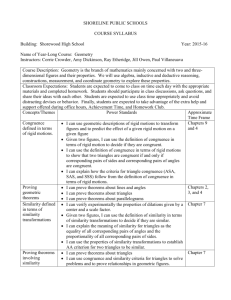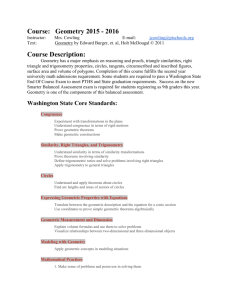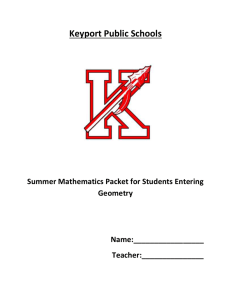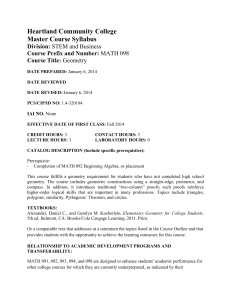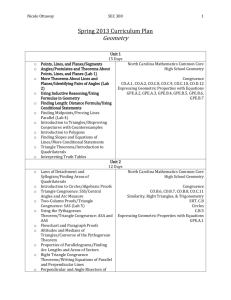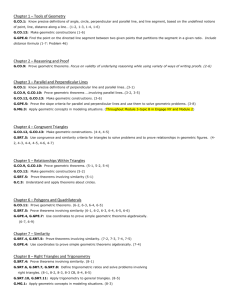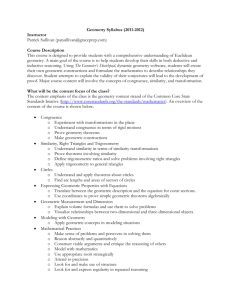Geometry Curriculum Map
advertisement
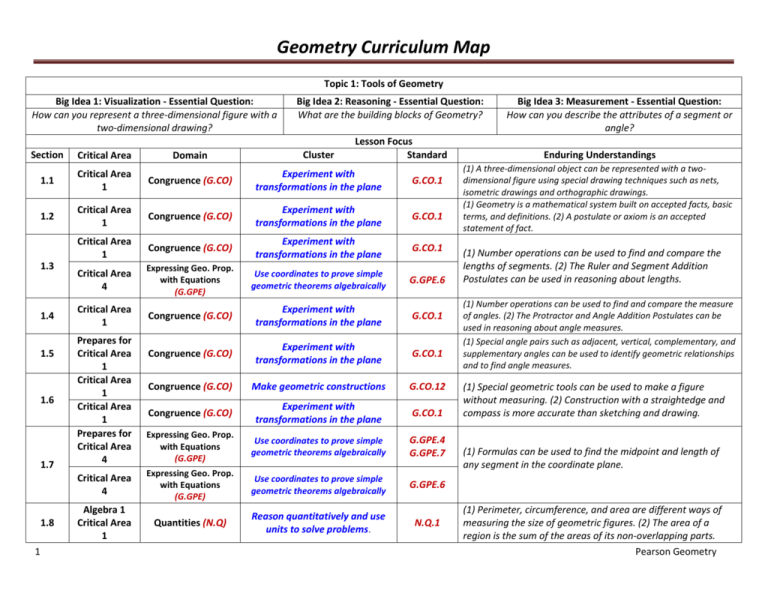
Geometry Curriculum Map Topic 1: Tools of Geometry Big Idea 1: Visualization - Essential Question: How can you represent a three-dimensional figure with a two-dimensional drawing? Big Idea 2: Reasoning - Essential Question: What are the building blocks of Geometry? Lesson Focus Standard Section Critical Area Domain Cluster 1.1 Critical Area 1 Congruence (G.CO) Experiment with transformations in the plane G.CO.1 1.2 Critical Area 1 Congruence (G.CO) Experiment with transformations in the plane G.CO.1 Critical Area 1 Congruence (G.CO) Experiment with transformations in the plane G.CO.1 Critical Area 4 Expressing Geo. Prop. with Equations (G.GPE) Use coordinates to prove simple geometric theorems algebraically G.GPE.6 Critical Area 1 Congruence (G.CO) Experiment with transformations in the plane G.CO.1 Congruence (G.CO) Experiment with transformations in the plane G.CO.1 Congruence (G.CO) Make geometric constructions G.CO.12 Congruence (G.CO) Experiment with transformations in the plane G.CO.1 Expressing Geo. Prop. with Equations (G.GPE) Use coordinates to prove simple geometric theorems algebraically G.GPE.4 G.GPE.7 Critical Area 4 Expressing Geo. Prop. with Equations (G.GPE) Use coordinates to prove simple geometric theorems algebraically G.GPE.6 Algebra 1 Critical Area 1 Quantities (N.Q) Reason quantitatively and use units to solve problems. N.Q.1 1.3 1.4 1.5 1.6 1.7 1.8 1 Prepares for Critical Area 1 Critical Area 1 Critical Area 1 Prepares for Critical Area 4 Big Idea 3: Measurement - Essential Question: How can you describe the attributes of a segment or angle? Enduring Understandings (1) A three-dimensional object can be represented with a twodimensional figure using special drawing techniques such as nets, isometric drawings and orthographic drawings. (1) Geometry is a mathematical system built on accepted facts, basic terms, and definitions. (2) A postulate or axiom is an accepted statement of fact. (1) Number operations can be used to find and compare the lengths of segments. (2) The Ruler and Segment Addition Postulates can be used in reasoning about lengths. (1) Number operations can be used to find and compare the measure of angles. (2) The Protractor and Angle Addition Postulates can be used in reasoning about angle measures. (1) Special angle pairs such as adjacent, vertical, complementary, and supplementary angles can be used to identify geometric relationships and to find angle measures. (1) Special geometric tools can be used to make a figure without measuring. (2) Construction with a straightedge and compass is more accurate than sketching and drawing. (1) Formulas can be used to find the midpoint and length of any segment in the coordinate plane. (1) Perimeter, circumference, and area are different ways of measuring the size of geometric figures. (2) The area of a region is the sum of the areas of its non-overlapping parts. Pearson Geometry Geometry Curriculum Map Topic 2: Reasoning and Proof Big Idea 1: Visualization - Essential Question: How can you make a conjecture and prove that it is true? Section Critical Area 2.1 Prepares for Critical Area 1 Congruence (G.CO) Prove geometric theorems 2.2 Critical Area 1 Congruence (G.CO) Prove geometric theorems 2.3 Critical Area 1 Congruence (G.CO) Prove geometric theorems 2.4 Prepares for Critical Area 1 Congruence (G.CO) Prove geometric theorems 2.5 Prepares for Critical Area 1 Congruence (G.CO) Prove geometric theorems G.CO.9 G.CO.10 G.CO.11 2.6 Critical Area 1 Congruence (G.CO) Prove geometric theorems G.CO.9 2 Domain Cluster Lesson Focus Standard G.CO.9 G.CO.10 G.CO.11 G.CO.9 G.CO.10 G.CO.11 G.CO.9 G.CO.10 G.CO.11 G.CO.9 G.CO.10 G.CO.11 Enduring Understandings (1) Patterns in some number sequences and some sequences of geometric figures can be used to discover relationships. (2) Conjectures are not valid unless they are proven true. (3) One counterexample can prove that a conjecture is false. (1) Some mathematical relationships can be described using a variety of if-then statements. (2) Each conditional statement has a converse, an inverse, and a contra-positive. (1) A definition is good if it can be written as a bi-conditional. (2) Every bi-conditional can be written as two conditionals that are converses of each other. (1) Given true statements, deductive reasoning can be used to make a valid or true conclusion. (2) Deductive reasoning often involves the Laws of Syllogism and Detachment. (1) Logical reasoning from one step to another is essential in building a proof. (2) Reasons in a proof include given information, definitions, properties, postulates and previously proven theorems. (1) Given information, definitions, properties, postulates and previously proven theorems can be used as reasons in a proof. Pearson Geometry Geometry Curriculum Map Topic 3: Parallel and Perpendicular Lines Big Idea 1: Reasoning and Proof - Essential Question: How do you prove that two lines are parallel or perpendicular? Section 3.1 3 Critical Area Critical Area 1 Domain Congruence (G.CO) Big Idea 2: Measurement - Essential Question: Big Idea 3: Coordinate Geometry - Essential Question: How do you write an equation of a line in a coordinate plane? What is the sum of the measures of the angles of a triangle? Lesson Focus Cluster Standard Enduring Understandings Experiment with (1) Not all lines and not all planes intersect. (2) When a line G.CO.1 transformations in the plane intersects two or more lines, the angles forms at the intersection points create special angle pairs. Prove geometric theorems G.CO.9 Prepares for Critical Area 1 Congruence (G.CO) 3.2 Critical Area 1 Congruence (G.CO) Prove geometric theorems G.CO.9 3.3 Extends Critical Area 1 Congruence (G.CO) Prove geometric theorems G.CO.9 3.4 Critical Area 2 Modeling with Geometry (G.MG) Apply geometric concepts in modeling situations G.MG.3 3.5 Critical Area 1 Congruence (G.CO) Prove geometric theorems G.CO.10 3.6 Critical Area 1 Congruence (G.CO) Make geometric constructions G.CO.12 G.CO.13 3.7 Prepares for Critical Area 4 Expressing Geo. Prop. with Equations (G.GPE) Use coordinates to prove simple geometric theorems algebraically G.GPE.5 3.8 Critical Area 4 Expressing Geo. Prop. with Equations (G.GPE) Use coordinates to prove simple geometric theorems algebraically G.GPE.5 (1) The special angle pairs formed by parallel lines and a transversal area either congruent or supplementary. Geometric postulates and theorems can be combined with algebra to find angle measures. (1) Certain angle pairs can be used to decide whether two angles are parallel. (2) Paragraph, two-column, and flow proofs are three forms of proof. (1) The relationships of two lines to a third line can be used to decide whether two lines are parallel or perpendicular to each other. (1) The sum of the angle measures of a triangle is always the same. (2) Any exterior angle of a triangle has a special relationship with the two remote interior angles of a triangle. (1) Parallel and perpendicular lines can be constructed with a straightedge and compass. (2) Special quadrilaterals can be constructed with a straightedge and compass. (1) A line can be graphed and its equation written when certain facts about the line, such as its slope and a point on the line are known. (2) The equation of a line can be written in various forms. (1) Comparing the slopes of two lines can show whether the lines are parallel or perpendicular. (2) The relationship between parallel or perpendicular can sometimes be used to write the equation of a line. Pearson Geometry Geometry Curriculum Map Topic 4: Congruent Triangles Big Idea 1: Visualization - Essential Question: How do you identify corresponding parts of congruent triangles? Big Idea 2: Reasoning and Proof - Essential Question: How do you show that two triangles are congruent? Lesson Focus Cluster Standard Section Critical Area Domain 4.1 Prepares for Critical Area 2 Similarity, Right Triangles, & Trigonometry (G.SRT) 4.2 Critical Area 2 Similarity, Right Triangles, & Trigonometry (G.SRT) Prove theorems involving similarity G.SRT.5 4.3 Critical Area 2 Similarity, Right Triangles, & Trigonometry (G.SRT) Prove theorems involving similarity G.SRT.5 Critical Area 2 Similarity, Right Triangles, & Trigonometry (G.SRT) Prove theorems involving similarity G.SRT.5 Critical Area 1 Congruence (G.CO) 4.4 Critical Area 1 4.5 Critical Area 2 4 Congruence (G.CO) Congruence (G.CO) Similarity, Right Triangles, & Trigonometry (G.SRT) Prove theorems involving similarity Make geometric constructions Prove geometric theorems Make geometric constructions Prove theorems involving similarity G.SRT.5 Big Idea 3: Reasoning and Proof - Essential Question: How can you tell whether a triangle is isosceles or equilateral? Enduring Understandings (1) Comparing the corresponding parts of two figures can show whether the figures are congruent. (1) Two triangles can be proven to be congruent without having to show that all corresponding parts are congruent. (2) Two ways triangles can be proven to be congruent are by using three pairs of corresponding sides or by using two pairs of corresponding sides and one pair of corresponding angles. (1) Two triangles can be proven to be congruent without having to show that all corresponding parts are congruent. (2) Another way triangles can be proven to be congruent is by using one pair of corresponding sides and two pairs of corresponding angles. (1) If two triangles are congruent, then every pair of their corresponding parts are also congruent. G.CO.12 G.CO.10 G.CO.13 (1) The angles and sides of isosceles and equilateral triangles have special relationships. G.SRT.5 Pearson Geometry Geometry Curriculum Map Topic 4: Congruent Triangles (Continued) Big Idea 1: Visualization - Essential Question: Big Idea 2: Reasoning and Proof - Essential Big Idea 3: Reasoning and Proof - Essential Question: Question: How do you identify corresponding parts of congruent How do you show that two triangles are How can you tell whether a triangle is isosceles or triangles? congruent? equilateral? Lesson Focus Section Critical Area Cluster Standard Enduring Understandings Domain (1) Two triangles can be proven to be congruent without Similarity, Right having to show that all corresponding parts are congruent. (2) Critical Area Triangles, & Prove theorems involving 4.6 G.SRT.5 Another way triangles can be proven to be congruent is by 2 Trigonometry similarity using one pair of right angles, a pair of hypotensuses and a (G.SRT) pair of legs. Similarity, Right (1) Congruent corresponding parts of one pair of congruent Critical Area Triangles, & Prove theorems involving 4.7 G.SRT.5 triangles can sometimes be used to prove another pair of 2 Trigonometry similarity triangles congruent. This often involves overlapping triangles. (G.SRT) 5 Pearson Geometry Geometry Curriculum Map Topic 5: Relationships within Triangles Big Idea 1: Coordinate Geometry - Essential Question: How do you use coordinate geometry to find relationships within triangles? Section 5.1 5.2 5.3 5.4 Critical Area Critical Area 1 Critical Area 2 Domain Congruence (G.CO) Congruence (G.CO) Similarity, Right Triangles, & Trigonometry (G.SRT) Big Idea 2: Measurement - Essential Question: Big Idea 3: Reasoning and Proof - Essential Question: How do you solve problems that involve How do you write indirect proofs? measurements of triangles? Lesson Focus Cluster Standard Enduring Understandings Prove geometric theorems G.CO.10 (1) To draw a mid-segment, students must find the midpoint of Make geometric constructions G.CO.12 two sides of a triangle and draw the segment joining the midpoints. (2) The mid-segment of a triangle is related to the Prove theorems involving G.SRT.5 third side in two ways. similarity Critical Area 1 Congruence (G.CO) Prove geometric theorems G.CO.9 Critical Area 2 Similarity, Right Triangles, & Trigonometry (G.SRT) Prove theorems involving similarity G.SRT.5 Critical Area 5 Circles (G.C) Understand and apply theorems about circles G.C.3 Critical Area 1 Congruence (G.CO) Prove geometric theorems G.CO.10 Critical Area 2 Similarity, Right Triangles, & Trigonometry (G.SRT) Prove theorems involving similarity G.SRT.5 (1) There is a special relationship between the points on the perpendicular bisector of a segment and the endpoints of a segment. (2) There is a special relationship between the points on the bisector of an angle and the sides of an angle. (1) A triangle’s three perpendicular angle bisectors are always concurrent. (2) A triangle’s three angle bisectors are always concurrent. (1) A triangle’s three medians are always concurrent. (2) A triangle’s three altitudes are always concurrent. Topic 5: Relationships within Triangles (Continued) 6 Pearson Geometry Geometry Curriculum Map Big Idea 1: Coordinate Geometry - Essential Question: How do you use coordinate geometry to find relationships within triangles? Section Critical Area Domain 5.5 Extends Critical Area 1 Congruence (G.CO) 5.6 5.7 7 Extends Critical Area 1 Extends Critical Area 1 Congruence (G.CO) Congruence (G.CO) Big Idea 2: Measurement - Essential Question: Big Idea 3: Reasoning and Proof - Essential Question: How do you solve problems that involve How do you write indirect proofs? measurements of triangles? Lesson Focus Cluster Standard Enduring Understandings (1) In indirect reasoning, all possibilities are considered and then all but one are proved false. The remaining possibility Prove geometric theorems G.CO.10 must be true. (2) An essential element of an indirect proof is showing a contradiction. (1) The measures of the angles of a triangle are related to the Prove geometric theorems G.CO.10 lengths of the opposite sides. The sum of the lengths of two sides of a triangle is related to the length of the third side. In triangles that have two pairs of congruent sides, there is a Prove geometric theorems G.CO.10 relationship between the included angles and the third pair of sides. Pearson Geometry Geometry Curriculum Map Topic 6: Polygons and Quadrilaterals Big Idea 1: Measurement - Essential Question: How can you find the sum of the measures of polygon angles? Big Idea 2: Reasoning and Proof - Essential Question: How can you classify quadrilaterals? Lesson Focus Standard Section Critical Area Domain Cluster 6.1 Critical Area 2 Similarity, Right Triangles, & Trigonometry (G.SRT) Prove theorems involving similarity G.SRT.5 Prove geometric theorems G.CO.11 Prove theorems involving similarity G.SRT.5 Prove geometric theorems G.CO.11 Critical Area 1 6.2 Critical Area 2 Critical Area 1 6.3 6.4 6.5 6.6 8 Congruence (G.CO) Similarity, Right Triangles, & Trigonometry (G.SRT) Congruence (G.CO) Critical Area 2 Similarity, Right Triangles, & Trigonometry (G.SRT) Prove theorems involving similarity G.SRT.5 Critical Area 1 Congruence (G.CO) Prove geometric theorems G.CO.11 Critical Area 2 Similarity, Right Triangles, & Trigonometry (G.SRT) Prove theorems involving similarity G.SRT.5 Critical Area 1 Congruence (G.CO) Prove geometric theorems G.CO.11 Critical Area 2 Similarity, Right Triangles, & Trigonometry (G.SRT) Prove theorems involving similarity G.SRT.5 Critical Area 2 Similarity, Right Triangles, & Trigonometry (G.SRT) Prove theorems involving similarity G.SRT.5 Big Idea 3: Coordinate Geometry - Essential Question: How can you use coordinate geometry to prove general relationships? Enduring Understandings (1) The sum of the angle measures of a polygon depends on the number of sides the polygon has. (1) Parallelograms have special properties regarding their sides, angles and diagonals. (2) Parallelograms can be used to prove theorems about parallel lines and their transversals. (1) If a quadrilateral’s sides, angles and diagonals have certain properties, it can be shown that the quadrilateral is a parallelogram. (2) The properties of parallelograms and algebra can be used to find the lengths of some sides and the measures of some angles of some parallelograms. (1) The special parallelograms, rhombus, rectangle, and square have basic properties about their sides, angles, and diagonals that helped identify them. (1) A parallelogram can be shown to be a rhombus, rectangle, or square based on the properties of its diagonals. (1) The angles, sides, and diagonals of a trapezoid have certain properties. Pearson Geometry Geometry Curriculum Map Topic 6: Polygons and Quadrilaterals Big Idea 1: Measurement - Essential Question: How can you find the sum of the measures of polygon angles? Big Idea 3: Coordinate Geometry - Essential Question: How can you use coordinate geometry to prove general relationships? Domain Expressing Geo. Prop. with Equations (G.GPE) Lesson Focus Cluster Standard Use coordinates to prove simple geometric theorems G.GPE.7 algebraically Critical Area 4 Expressing Geo. Prop. with Equations (G. GPE) Use coordinates to prove simple geometric theorems algebraically G.GPE.4 (1) Using variables to name the coordinates of a figure allows relationships to be shown to be true for a general case. Critical Area 4 Expressing Geo. Prop. with Equations (G. GPE) Use coordinates to prove simple geometric theorems algebraically G.GPE.4 (1) Geometric relationships can be proven using variable coordinates for figures in the coordinate plane. Section Critical Area 6.7 Critical Area 4 6.8 6.9 9 Big Idea 2: Reasoning and Proof - Essential Question: How can you classify quadrilaterals? Enduring Understandings (1) The formulas for slope, distance, and midpoint can be used to classify and prove geometric relationships for figures in the coordinate plane . Pearson Geometry Geometry Curriculum Map Topic 7: Similarity Big Idea 1: Similarity - Essential Question: How do you use proportions to find side lengths in similar polygons? Section Critical Area 7.1 Critical Area 2 7.2 Critical Area 2 Critical Area 2 7.3 Critical Area 4 Critical Area 2 7.4 Critical Area 4 7.5 10 Critical Area 2 Domain Similarity, Right Triangles, & Trigonometry (G.SRT) Similarity, Right Triangles, & Trigonometry (G.SRT) Similarity, Right Triangles, & Trigonometry (G.SRT) Expressing Geo. Prop. with Equations (G.GPE.5) Similarity, Right Triangles, & Trigonometry (G.SRT) Expressing Geo. Prop. with Equations (G.GPE.5) Similarity, Right Triangles, & Trigonometry (G.SRT) Big Idea 2: Reasoning and Proof - Essential Question: How do you show two triangles are similar? Cluster Lesson Focus Standard Prove theorems involving similarity G.SRT.5 Prove theorems involving similarity G.SRT.5 Prove theorems involving similarity G.SRT.5 Use coordinates to prove simple geometric theorems algebraically G.GPE.6 Prove theorems involving similarity G.SRT.5 Use coordinates to prove simple geometric theorems algebraically G.GPE.6 Prove theorems involving similarity G.SRT.4 Big Idea 3: Visualization - Essential Question: How do you identify corresponding parts of similar triangles? Enduring Understandings (1) A ratio can be written to compare two quantities. (2) an equation can be written stating that two ratios are equal. (3) If the equation contains a variable, it can be solved to find the value of the variable. (1) Ratios and proportions can be used to decide whether two polygons are similar and to find the unknown side lengths of similar figures. (2) All lengths in a scale drawing are proportional to their corresponding actual lengths. (1) Triangles can be shown to be similar based on the relationship of two or three pairs of corresponding parts. (2) Similar triangles can be used to find unknown measurements. (1) Drawing in the altitude to the hypotenuse of a right triangle forms three pairs of similar right triangles. (2) The altitude to the hypotenuse of a right triangle, the segments formed by the altitude, and the sides of the right triangles have lengths that are related using geometric means. (1) When two or more parallel lines intersect other lines, proportional segments are formed. (2) The bisector of an angle of a triangle divides the opposite side into two segments with lengths proportional to the sides of the triangle that form the angle Pearson Geometry Geometry Curriculum Map Topic 8: Right Triangles and Trigonometry Big Idea 1: Measurement - Essential Question: How do you find a side length or angle measurement in a right triangle? Section 8.1 8.2 8.3 Domain Cluster Critical Area 2 Similarity, Right Triangles, & Trigonometry (G.SRT) Define trigonometric ratios and solve problems involving right triangles Critical Area 2 Critical Area 2 Critical Area 2 8.4 Critical Area 2) 8.5 Critical Area 2 Similarity, Right Triangles, & Trigonometry (G.SRT) 8.6 Critical Area 2 Similarity, Right Triangles, & Trigonometry (G.SRT) 11 Lesson Focus Standard Critical Area Similarity, Right Triangles, & Trigonometry (G.SRT) Similarity, Right Triangles, & Trigonometry (G.SRT) Modeling with Geometry (G.MG) Similarity, Right Triangles, & Trigonometry (G.SRT) Big Idea 2: Similarity - Essential Question: How do trigonometric ratios relate to similar right triangles? G.SRT.8 Define trigonometric ratios and solve problems involving right triangles G.SRT.8 Define trigonometric ratios and solve problems involving right triangles G.SRT.8 G.SRT.7 Apply geometric concepts in modeling situations G.MG.1 Define trigonometric ratios and solve problems involving right triangles G.SRT.8 Apply trigonometry to general triangles Apply trigonometry to general triangles G.SRT.11 G.SRT.10 G.SRT.11 G.SRT.10 Enduring Understandings (1) If the lengths of any two sides of a right triangle are known, the length of the third side can be found using the Pythagorean Theorem. (2) If the lengths of all sides of a triangle are known, it can be determined whether the triangle is acute, right, or obtuse. (1) Certain right triangles have properties that allow their side lengths to be determined without using the Pythagorean Theorem. (1) If certain combinations of side lengths and angle measures of a right triangle are known, ratios can be used to find other side lengths and angle measures. (1) The angles of elevation and depression are the acute angles of right triangles formed by a horizontal distance and a vertical height. (1) If the measures of two angles and a side of a triangle are known (AAS or ASA), or if the measures of two sides and a nonincluded angle are known (SSA), all the other measures of the triangle can be found. (1) If the measures of two sides lengths of a triangle and their included angle (SAS) are known, or all three side lengths are known (SSS), all the other measures of the triangle can be found. Pearson Geometry Geometry Curriculum Map Topic 9: Right Triangles and Trigonometry Big Idea 1: Transformations - Essential Question: Big Idea 2: Coordinate Geometry - Essential Big Idea 3: Visualization - Essential Question: Question: How can you change a figure's position without changing its size and How can you represent a transformation in the How do you recognize congruence shape? How can you change a figure's size without changing its shape? coordinate plane? and similarity in figures? Lesson Focus Section Critical Area Cluster Standard Enduring Understandings Domain (1) The location and orientation of a geometric figure can be Critical Area Experiment with G.CO.1 Congruence (G.CO) changed while preserving the distance and angle measures. (2) 1 transformations in the plane G.CO.4 9.1 The distance between any two points, angle measures, and Critical Area Understand congruence in terms orientation of a geometric figure remain the same when the Congruence (G.CO) G.CO.6 1 of rigid motions figure is translated in one direction. G.CO.2 Critical Area Experiment with Congruence (G.CO) G.CO.4 (1) When you reflect a figure across a line, each point of the 1 transformations in the plane G.CO.5 9.2 figure goes to another point the same distance from the line, but on the other side. Critical Area Understand congruence in terms Congruence (G.CO) G.CO.6 1 of rigid motions Critical Area Experiment with G.CO.2 Congruence (G.CO) 1 transformations in the plane G.CO.4 (1) Distances, angle measures, and orientation of a geometric 9.3 figure is rotated about a center of rotation. Critical Area Understand congruence in terms Congruence (G.CO) G.CO.6 1 of rigid motions Critical Area Experiment with Congruence (G.CO) G.CO.5 (1) If there is an isometry that maps a figure to another, then 1 transformations in the plane 9.4 you can map one onto the other by using a composition of Critical Area Understand congruence in terms reflections. Congruence (G.CO) G.CO.6 1 of rigid motions G.CO.6 Critical Area Understand congruence in terms (1) If two figures can be mapped to each other by a sequence 9.5 Congruence (G.CO) G.CO.7 1 of rigid motions of rigid motions, then the figures are congruent. G.CO.8 Similarity, Right G.SRT.1a Critical Area Triangles, & Apply trigonometry to general (1) A scale factor can be used to make a larger or smaller copy 9.6 G.SRT.1b 1 Trigonometry triangles of a figure that is also similar to the original figure. G.SRT.2 (G.SRT) 12 Pearson Geometry Geometry Curriculum Map Topic 9: Right Triangles and Trigonometry Big Idea 1: Transformations - Essential Question: Big Idea 2: Coordinate Geometry - Essential Big Idea 3: Visualization - Essential Question: Question: How can you change a figure's position without changing its size and How can you represent a transformation in the How do you recognize congruence shape? How can you change a figure's size without changing its shape? coordinate plane? and similarity in figures? Lesson Focus Section Critical Area Cluster Standard Enduring Understandings Domain Similarity, Right (1) Compositions of rigid motions and dilations can be used to Critical Area Triangles, & Apply trigonometry to general G.SRT.2 understand the properties of similarity. (2) Two figures are 9.7 1 Trigonometry triangles G.SRT.3 similar if there is a similarity transformation that maps one (G.SRT) onto the other. 13 Pearson Geometry Geometry Curriculum Map Topic 10: Area Big Idea 1: Measurement - Essential Question: Big Idea 2: Similarity - Essential Question: How do you find the area of a polygon or find the circumference and area of a How do perimeters and areas of similar polygons compare? circle? Lesson Focus Section Critical Area Cluster Standard Enduring Understandings Domain Critical Area Modeling with Apply geometric concepts in G.MG.1 3 Geometry (G.MG) modeling situations (1) The area of a parallelogram or a triangle can be found 10.1 Expressing Geo. Use coordinates to prove simple when the length of its base and its height are known. Critical Area Prop. with geometric theorems G.GPE.7 4 Equations (G. GPE) algebraically (1) The area of a trapezoid can be found when the lengths of its Critical Area Modeling with Apply geometric concepts in 10.2 G.MG.1 base and its height are known. (2) The area of a rhombus or 3 Geometry (G.MG) modeling situations kite can be found when the lengths of its diagonals are known. Critical Area Modeling with Apply geometric concepts in G.MG.1 3 Geometry (G.MG) modeling situations (1) The area of a regular polygon is a function of the distance 10.3 from the center to a side and the perimeter. Critical Area Congruence (G.CO) Make geometric constructions G.CO.13 1 10.4 10.5 10.6 14 Prepares for Critical Area 3 Geometric Measurement & Dimension (G.SRT) Critical Area 2 Similarity, Right Triangles, & Trigonometry (G.SRT) Apply trigonometry to general triangles G.SRT.9 Critical Area 1 Congruence (G.CO) Experiment with transformations in the plane G.CO.1 Critical Area 5 Critical Area 5 Circles (G.C) Circles (G.C) Explain volume formulas and use them to solve problems Understand and apply theorems about circles Find arc lengths and areas of sectors of circles G.GMD.3 G.C.1 G.C.2 (1) Ratios can be used to compare the perimeters and areas of similar figures. (1) Trigonometry can be used to find the area of a regular polygon when the length of a side, radius, or apothem is known. (2) Trigonometry can be used to find the area of a triangle when the lengths of two side and the included angle are known . (1) The length of part of a circle's circumference can be found by relating it to a central angle of the circle. G.C.5 Pearson Geometry Geometry Curriculum Map Topic 10: Area (Continued) Big Idea 1: Measurement - Essential Question: Big Idea 2: Similarity - Essential Question: How do you find the area of a polygon or find the circumference and area of a How do perimeters and areas of similar polygons compare? circle? Lesson Focus Section Critical Area Cluster Standard Enduring Understandings Domain (1) The area of a circle can be found when the circle's radius is Critical Area Find arc lengths and areas of known. (2) The area of parts of a circle formed by the radii and 10.7 Circles (G.C) G.C.5 5 sectors of circles an arc can be found when the circle's radius and the arc measure are known. Conditional Prepares for Understand independence and Probability & the (1) Certain problems in probability can be solved by modeling 10.8 Critical Area conditional probability and use S.CP.1 Rules of Probability the situation with geometric measures. 6 them to interpret data (S.CP) 15 Pearson Geometry Geometry Curriculum Map Topic 11: Surface Area and Volume Big Idea 1: Visualization - Essential Question: How can you determine the intersection of a solid and a plane? Big Idea 2: Measurement - Essential Question: How do you find the surface area and volume of a solid? Lesson Focus Cluster Standard Big Idea 3: Similarity - Essential Question: How do the surface areas and volumes of similar solids compare? Section Critical Area Domain 11.1 Critical Area 3 Geometric Measurement & Dimension (G.GMD) Experiment with transformations in the plane G.GMD.4 (1) A three-dimensional figure can be analyzed by describing the relationships between its vertices, edges and faces. (2) A cross-section is the intersection of a three-dimensional figure and a plane. 11.2 Critical Area 3 Modeling with Geometry (G.MG) Apply geometric concepts in modeling situations G.MG.1 (1) The area of a three-dimensional figure is equal to the sum of the areas of each surface of the figure. 11.3 Critical Area 3 Modeling with Geometry (G.MG) Apply geometric concepts in modeling situations G.MG.1 1) The area of a three-dimensional figure is equal to the sum of the areas of each surface of the figure. Critical Area 3 Geometric Measurement & Dimension (G.GMD) Explain volume formulas and use them to solve problems G.GMD.1 G.GMD.2 G.GMD.3 Critical Area 3 Modeling with Geometry (G.MG) Apply geometric concepts in modeling situations G.MG.1 11.4 16 Enduring Understandings (1) The volume of a prism and a cylinder can be found when its height and the area of the base are known. (2) The volume of a composite space figure is the sum of the volumes of the figures that are combined. Pearson Geometry Geometry Curriculum Map Topic 11: Surface Area and Volume (Continued) Big Idea 1: Visualization - Essential Question: How can you determine the intersection of a solid and a plane? Section 11.5 Critical Area Critical Area 3 Critical Area 3 11.6 11.7 17 Critical Area 3 Critical Area 3 Critical Area 2 Domain Geometric Measurement & Dimension (G.GMD) Modeling with Geometry (G.MG) Geometric Measurement & Dimension (G.GMD) Modeling with Geometry (G.MG) Modeling with Geometry (G.MG) Big Idea 2: Measurement - Essential Question: How do you find the surface area and volume of a solid? Lesson Focus Cluster Standard Explain volume formulas and use them to solve problems G.GMD.3 Apply geometric concepts in modeling situations G.MG.1 Explain volume formulas and use them to solve problems G.GMD.3 Apply geometric concepts in modeling situations Apply geometric concepts in modeling situations Big Idea 3: Similarity - Essential Question: How do the surface areas and volumes of similar solids compare? Enduring Understandings (1) The volume of a pyramid is related to the volume of a prism with the same base and height. (2) The volume of a cone is related to the volume of a cylinder with the same base and height. (1) The surface area and the volume of a sphere can be found when its radius is known. G.MG.1 G.MG.1 G.MG.2 (1) Ratios can be used to compare the areas and volumes of similar solids. Pearson Geometry Geometry Curriculum Map Topic 12: Circles Big Idea 1: Reasoning and Proof - Essential Question: How can you prove relationships between angles and arcs in a circle? Section Critical Area 12.1 Critical Area 5 12.2 Critical Area 5 Domain Big Idea 2: Measurement - Essential Question: When lines intersect a circle or within a circle, how do you find the measures of resulting angles, arcs, and segments? Lesson Focus Cluster Standard Enduring Understandings Circles (G.C) Understand and apply theorems about circles Circles (G.C) Understand and apply theorems about circles G.C.2 12.3 Critical Area 5 Circles (G.C) Understand and apply theorems about circles G.C.2 G.C.3 G.C.4 12.4 Critical Area 5 Circles (G.C) Understand and apply theorems about circles G.C.2 12.5 Critical Area 5 12.6 Critical Area 3 Expressing Geo. Prop. with Equations (G.GPE) Geometric Measurement & Dimension (G.SRT) Translate between the geometric description and the equation for a conic section Visualize relationships between two-dimensional and threedimensional objects 18 Big Idea 3: Coordinate Geometry Essential Question: How do you find the equation of a circle in a coordinate plane? G.C.2 G.GPE.1 G.GMD.4 (1) A radius of a circle and the tangent that intersects the endpoint of the radius on the circle have a special relationship. (2) A circle has a special relationship to a triangle whose sides are tangent to the circle. (1) Information about congruent parts of a circle (or congruent circles) can be used to find information about other parts of the circle (or circles). (1) Angles formed by intersecting lines have a special relationship to the arcs the intersecting lines intercept. (2) Specifically, arcs intercepted by chords that form inscribed angles are related to the inscribed angles. (1) Angles formed by intersecting lines have a special relationship to the arcs the intersecting lines intercept. (2) Arcs formed by lines intersecting either within a circle or outside a circle are related to the angles formed by the lines. (3) There are special relationships between intersecting chords, intersecting secants, or a secant and tangent that intersect. (1) The information in the equation of a circle allows the circle to be graphed. (2) The equation of a circle can be written if its center and radius are known. (1) The description of a locus can be used to sketch a geometric relationship. Pearson Geometry Geometry Curriculum Map Topic 13: Probability Big Idea 1: Probability - Essential Question: What is the difference between experimental probability and theoretical probability? Section Critical Area 13.1 Critical Area 6 13.2 Critical Area 6 13.3 Critical Area 6 13.4 Critical Area 6 13.5 Critical Area 6 Critical Area 6 13.6 Critical Area 6 19 Domain Conditional Probability & the Rules of Probability (S.CP) Conditional Probability & the Rules of Probability (S.CP) Conditional Probability & the Rules of Probability (S.CP) Conditional Probability & the Rules of Probability (S.CP) Conditional Probability & the Rules of Probability (S.CP) Conditional Probability & the Rules of Probability (S.CP) Conditional Probability & the Rules of Probability (S.CP) Big Idea 2: Data Representation - Essential Question: What is a frequency table? Cluster Lesson Focus Standard Big Idea 3: Probability - Essential Question: What does it mean for an event to be random? Enduring Understandings Understand independence and conditional probability and use them to interpret data S.CP.1 S.CP.4 (1) Probability is the measure of the likelihood that an event will occur . Understand independence and conditional probability and use them to interpret data S.CP.4 S.CP.5 (1) Tables can be used to organize data by frequency and find probabilities. S.CP.9 (1) Counting techniques can be used to find all of the possible ways to complete different tasks or choose items from a list. S.CP.7 S.CP.8 S.CP.9 (1) The probability of compound events can be found using the probability of each part of the compound event.. Understand independence and conditional probability and use them to interpret data S.CP.4 (1) Two-way frequency tables can be used to organize data, identify sample spaces and approximate probabilities. (2) In real-world situations, frequency tables can be used to find conditional probabilities and determine if treatments are effective. Understand independence and conditional probability and use them to interpret data S.CP.2 S.CP.3 S.CP.5 Use the rules of probability to compute probabilities of compound events in a uniform probability model S.CP.6 Use the rules of probability to compute probabilities of compound events in a uniform probability model Use the rules of probability to compute probabilities of compound events in a uniform probability model (1) Tables, tree diagrams, and formulas can be used to find conditional probability. Pearson Geometry Geometry Curriculum Map Topic 13: Probability (Continued) Big Idea 1: Probability - Essential Question: What is the difference between experimental probability and theoretical probability? Section Critical Area 13.7 Critical Area 6 20 Domain Using Probability to Make Decisions (S.MD) Big Idea 2: Data Representation - Essential Question: What is a frequency table? Cluster Lesson Focus Standard Calculate expected values and use them to solve problems S.MD.6 S.MD.7 Big Idea 3: Probability - Essential Question: What does it mean for an event to be random? Enduring Understandings (1) Probability and random selection can be used in making appropriate and fair decisions . Pearson Geometry
